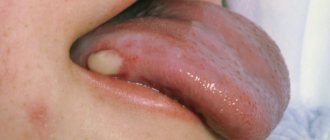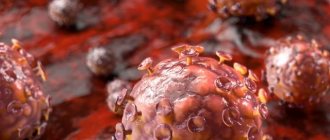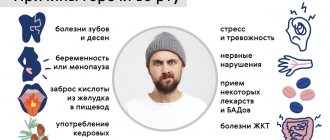A special cause for concern is teeth marks on the sides of the tongue, the causes of which cannot be found in previously identified diseases of the oral cavity. In this case, you cannot do without consulting a specialist - it is necessary to establish and then eliminate the provoking factor for the appearance of tooth imprints on the mucous membrane. Otherwise, there is a high risk of severe complications, including serious deviations in the activity of the endocrine system, digestive structures, and nerve conduction. Self-diagnosis and self-medication are unacceptable.
Why do teeth marks appear on the tongue and what to do about it?
If you notice teeth marks on your tongue, then this symptom should alert you. We must not forget that the tongue is a mirror of the body. It is through this organ that signals about various pathologies and diseases that require treatment can be received. We will talk about the most common of them in our article today.
What can cause teeth marks?
The tongue and oral cavity are the vestibule of the digestive system. It is from them that the process of assimilation of food coming from outside begins. Traces of teeth on the tongue appear when it is significantly enlarged and the tissues are swollen.
The main reasons for the appearance of fingerprints:
- congenital malocclusion;
- suffered psycho-emotional shocks, stress;
- depressive states;
- atrophic variant of glossitis;
- acquired hypothyroidism;
- xerostomia;
- pellagra.
In addition to clearly visible imprints on the tongue from pressing into the mucous membrane of the teeth, other pathological symptoms may be noticeable on the organ - discoloration, plaque, cracks, ulcers. In some cases, a change in the shape of the tongue is observed - its curvature.
Only a doctor can correlate the above provoking factors with the existing signs and symptoms of marks on the tongue. It is recommended not to delay visiting the dentist so that complications and serious consequences do not develop.
Malocclusion
If teeth marks and imprints on the sides appear on a muscular organ with enviable frequency, then we can assume that bite pathologies are to blame. Incorrect occlusion, displacement of the jaws and their asymmetrical arrangement relative to each other, crooked and crowded elements in the oral cavity are prerequisites for the emergence of a problem.
On a note! Depending on the type of pathology, tooth marks can appear along the edges of the tongue, at the tip, or at the root. The problem appears for the reason that when the jaws close, the muscular organ involuntarily tries to take a position corresponding to the location of the dentition.
When a person has an incorrect bite, the process of chewing food is disrupted, speech is difficult, the enamel is quickly erased, and the height of the crowns decreases. In this regard, situations arise when not only strong teeth marks appear on the tongue, but also chronic injuries in the oral cavity, ulcers and wounds caused by biting the mucous membrane and the muscular organ itself.
Nervous disorders
Involuntary clenching of the jaw, accompanied by biting the tongue, the presence of marks from the edges of the dentition, may be a consequence of excessive excitability and nervousness of a person.
The reasons may be:
- serious quarrel, conflict;
- Constantly being under stress is a difficult life situation that requires mental stress;
- congenital increased anxiety - from childhood the child overreacts to external factors, so he has other signs of hyperexcitability of the cerebral cortex, for example, enuresis;
- tendency to depression - a person’s perception of events in his life exclusively from the negative side;
- psycho-emotional shocks - death of a loved one, divorce, dismissal from work.
With constant involuntary clenching of the jaws (a person may not even realize this), imprints of teeth remain on the tongue. Subsequently, microtraumas will be complicated by secondary infection, the development of stomatitis, gingivitis, and other oral diseases.
To eliminate the problem, it is first recommended to seek advice from a neurologist and psychotherapist. They will prescribe medications necessary to correct the activity of the nervous system - herbal sedatives, and in case of severe disorder - inpatient treatment in a specialized department.
A person will also need to work on himself - working through existing psychological problems with a psychotherapist, searching for the causes of mental discomfort, and identifying ways to get rid of this kind of disorder.
Other dental problems
When teeth imprints constantly appear on the tongue and cheeks, while a person manages to bite and injure the mucous membrane, this can indicate not only malocclusions, but also other dental pathologies:
- incorrectly installed crowns, fillings and dentures,
- presence of chipped and damaged teeth,
- abnormal structure of the temporomandibular joint,
- bruxism,
- lack of teeth,
- anomalies in the growth and eruption of third molars: for example, “eights” can grow into the cheek, cause crowding of the row and provoke bite pathologies.
What could be the consequences?
If any general pathology has led to swelling of the tongue, then with untimely treatment or its complete absence, the health condition will only worsen. The following complications are possible:
- speech will be impaired, it will be difficult to pronounce some sounds;
- problems with bite over time lead to disruption of the gastrointestinal tract and other diseases;
- when the organ enlarges excessively, the teeth become displaced;
- psychological discomfort will appear;
- It will be difficult to wear dentures due to constant injury.
Main non-dental causes
Tongue diseases
If you notice an enlarged tongue with teeth marks in yourself or your child, then you should look for the problem in inflammation of the muscle organ. Often the cause of the pathology is a disease such as glossitis. There are many types of glossitis: desquamative, allergic, herpetic, ulcerative, hypertrophic, folded - read in detail about all types and forms in the feature article on the website.
When glossitis appears, other characteristic symptoms usually occur, in addition to the fact that tooth marks remain on the tongue:
- burning and itching of the muscle organ,
- redness, the appearance of plaque of different shades,
- pain and discomfort when eating food, when communicating with others,
- change in relief and structure: formation of cracks, ulcers, grooves, spots, erosions.
The causes of glossitis are very diverse: injuries, weak immunity, active reproduction of viruses and bacteria in the oral cavity, allergic reactions to personal hygiene products, medications and food.
Xerostomia (dry mouth)
A swollen tongue with teeth marks is often noticed by people who have impaired normal salivation. Xerostomia can occur in older people, as well as in those who take various medications for a long time. In some cases, the pathology is associated with dysfunction and inflammation of the salivary glands, autoimmune diseases (for example, Sjogren's syndrome), and hormonal disorders.
Another reason is dehydration after diseases accompanied by intoxication and high body temperature (poisoning, sore throat, influenza, ARVI and many others). Xerostomia affects people with diabetes, as well as those who frequently smoke and drink alcohol.
On a note! Sometimes dry mouth is normal. For example, the rate of salivation naturally decreases at night, which is why many people notice bad breath and teeth marks on the tongue after sleep. The problem can also appear after exhausting physical activity, sports, prolonged stay in stuffy rooms and in the open sun.
With a lack of saliva, the muscular organ becomes dry, may turn red, swell and increase in size, after which imprints appear on it and cracks appear. There are other signs of xerostomia:
- halitosis: bad breath,
- viscous and thick saliva,
- difficulty chewing and swallowing dry food,
- thirst.
If the problem of chronic xerostomia is not addressed, caries will progress, as well as other dental diseases (erosions, gingivitis and periodontitis, candidiasis). After all, the lack of a sufficient amount of saliva leads to the active proliferation of bacteria in the oral cavity and increased accumulation of plaque on the enamel, gums, and also under the gums.
Nervous disorders and stress
Teeth imprints on the sides of the tongue may indicate excessive nervous excitability and that the person has recently been in a stressful or conflict situation, experienced severe psycho-emotional shock, or is in a depressed state. Under nervous overload, you can involuntarily clench your jaws, squeeze the muscular organ between the lower and upper jaws, bite it, after which marks appear on its surface.
In rare cases, the problem indicates neurological disorders and neuroses, epileptic seizures in which a person cannot control himself. But then the patient not only bites a muscle organ, but can severely injure it, disrupt the integrity of the mucous membrane and tissue covering it, and cause bleeding.
Malfunction of the hypoglossal nerve
When an organ is displaced and occupies an unusual location for it, then teeth marks appear on it, as in the photo. Such an unpleasant phenomenon may be associated with pathological damage to the hypoglossal nerve resulting from a massive stroke or multiple sclerosis.
Pathologies of the gastrointestinal tract
A dense plaque of white, yellow or brown color appears, and after closing the jaws, tooth marks remain on the tongue if there is any disease of the gastrointestinal tract: gastritis, ulcers, colitis, pancreatitis, dysbacteriosis, acidity disorders.
Usually, with these pathologies, the patient is accompanied by halitosis, and plaque cannot be permanently removed with a brush and paste, since it constantly accumulates again. There are other characteristic symptoms of gastrointestinal pathologies: bloating, pain, stool disturbances, nausea, heaviness in the abdomen.
Endocrine system dysfunction
If a muscular organ has increased in size and swollen, and there are imprints of chewing teeth on it, then what does this mean? Perhaps an advanced stage of hypothyroidism, when the thyroid gland does not secrete enough hormones. Patients with this disease usually notice not only swelling of the muscle organ, but also swelling of the face and neck. Their hair begins to grow and fall out, their nails peel, their diction is impaired, their blood pressure and pulse rise, arrhythmia occurs, and their voice becomes hoarse.
Acute deficiency of vitamin B3 and nicotinic acid
Due to the lack of these substances in the body, a rare form of vitamin deficiency develops, which doctors call pellagra. The disease is quite rare, because vitamin B3, as well as nicotinic acid, are contained in almost all products that we, one way or another, consume: eggs, milk, all types of meat, liver, fish, carrots, potatoes, tomatoes, wheat. Experts believe that the pathology mainly occurs in people from disadvantaged environments and those who abuse alcohol.
With pellagra, the muscle organ swells, and therefore teeth marks periodically appear on the tip of the tongue or on its sides. There is a feeling of discomfort and burning in the mouth, the mucous membranes and gums itch, hurt, and itch. This disease brings with it many others: dementia, dermatitis, nervous disorders, paralysis of the limbs, dysfunction of the cardiovascular system.
Important! Teeth imprints on the tongue may indicate various diseases: hemolytic anemia[1], scarlet fever, cancer, tuberculosis, HIV. A swollen muscle organ on which imprints remain is sometimes a consequence of acute allergic reactions and Quincke's edema.
Hypothyroidism
A decrease in the production of thyroid hormones provokes a disease such as hypothyroidism. At the initial stage of its course, there are no obvious signs of pathology.
However, as the negative phenomena intensify, the patient will experience symptoms:
- swelling of the face – some puffiness;
- increase in size of the tongue - can be seen by the presence of clear teeth marks on the sides;
- hair loss – thinning strands, appearance of bald patches;
- change in speech – inhibition, slowness of pronunciation of sounds and words;
- some hoarseness of voice - a swollen and deformed tongue does not allow for clear diction.
There are functional changes in other internal organs - in addition to the tongue, the cardiovascular system suffers, for example, a person notes fluctuations in blood pressure and pulse, and episodes of arrhythmia.
Therapeutic measures are aimed at correcting the concentration of thyroid hormones in the tissues and bloodstream. The endocrinologist selects the optimal doses of medications with hormonal activity. Against the background of their regular use, negative symptoms - swelling of the tissues of the tongue, marks on its sides, puffiness of the face, obesity are eliminated.
Why does the problem occur in pregnant women?
Teeth imprints on the tongue during pregnancy may be associated with the pathologies that we listed earlier, but most often they appear for the following reasons:
- dehydration of the body against the background of severe toxicosis,
- iron deficiency anemia: the muscle organ becomes red, swollen and numb,
- candidal stomatitis: then the unpleasant symptom is accompanied by the appearance of a dense cheesy coating,
- lack of B vitamins and folic acid,
- physiological swelling of organs due to the accumulation of fluid in the body in late pregnancy.
“I constantly noticed this problem during pregnancy. Especially after I get nervous. It was very noticeable in the later stages, in the summer, in the very heat. I was also constantly thirsty, I always felt that my mouth was very dry, and my tongue was swollen as a result. And I drank water and drank... True, the doctor scolded me all the time, saying that my whole body and all my internal organs were swelling. As soon as I gave birth, everything returned to normal...”
Anastasia K., review from woman.ru
Atrophic glossitis
The inflammatory process directly in the tissues of the tongue is glossitis. With the atrophic variant of the pathology, the papillae on the surface of the taste organ are smoothed out, and then they disappear completely. The tongue becomes smooth, as if varnished, shiny. At the same time, the tissues swell, tooth marks remain on the sides, which causes obvious discomfort to the person. There is an unpleasant odor from the mouth.
Prerequisites for the disease:
- vitamin deficiency - insufficient consumption of useful microelements and vitamins in the human body or their excessive consumption, for example, due to heavy physical work or due to pregnancy;
- viral or fungal infections - tissue inflammation occurs when there is a high contamination of the mucous membrane of the tongue with pathogenic microorganisms, which leads to its increase and the appearance of teeth marks, as one of the signs of the disease;
- injuries – frequent consumption of too hot/cold foods, poor-quality dentures;
- oncological processes in the tissues of the tongue - at the initial stage they can make themselves felt precisely by swelling and the appearance of teeth marks on the sides.
The fight against unpleasant symptoms accompanying the course of atrophic glossitis is aimed at eliminating pain, swelling, changes in the color of the tongue and marks on its sides. For treatment the following is prescribed:
- rinsing with antiseptic solutions;
- taking antiviral and antibacterial drugs;
- nutrition correction;
- local use of healing ointments and lotions.
With timely comprehensive treatment, tooth imprints on the tongue completely disappear.
Associated symptoms
People who have imprints of their front or chewing teeth on their tongue often notice other alarming signs indicating pathological conditions:
- the muscular organ swells and increases in volume, becomes inflamed, changes its color, cracks, sores, erosions and spots appear on it,
- plaque formation: the density of plaque may depend on various factors - time of day, stage of development of a particular disease, nature of food consumed, frequency and thoroughness of hygiene procedures,
- it is difficult and painful to eat food, swallow it, talk,
- displacement of the tongue to the side, inability to control its position.
Some experts believe that if prints appear on the tip of an organ, this may indicate excessive nervous excitability and stress. If on the sides, then most often it indicates malocclusion pathologies, dental problems, diseases of the gastrointestinal tract, and pathologies of the endocrine system.
Xerostomia
Violation of salivation processes in the oral cavity - xerostomia. Its main features:
- drying of the mucous membrane of the tongue;
- increase in the volume of the tongue;
- the appearance of cracks on its surface, teeth marks on the sides;
- change in shade - the tongue becomes bright crimson;
- difficulty eating;
- distortion of taste perception - food becomes tasteless.
The background against which xerostomia develops is endocrine disorders, a sharp decrease in immunity, severe infectious processes, and pathologies of the salivary glands. Therefore, adequate treatment will be prescribed after establishing the true cause of the appearance of marks on the sides of the tongue.
Dentists urge you to pay attention to the slightest changes in the oral cavity - unpleasant sensations on the tongue, its swelling or traces of cracks, ulcers, cavities from the teeth. With timely consultation with a doctor, identification of the causes of the pathological phenomenon, as well as immediate treatment procedures, you can cope with any disease and restore health.
Removing fingerprints at home
Marks or imprints on the tongue are especially noticeable when there is plaque. To get rid of the problem, you can thoroughly clean the surface of the muscular organ with a brush or a special scraper. Afterwards, it is recommended to rinse the mouth well with water and mouthwash. Any antiseptic, soda solution, as well as herbal decoctions are also suitable for rinsing - all this is especially important if there are not only traces on the mucous membrane, but also ulcers, wounds or cracks, bleeding, if you are bothered by bad breath.
If the mucous membranes are dry, caused by dehydration or extreme heat, it is recommended to drink more liquid, in particular plain water, fruit drinks, and herbal teas. This will help restore the water-salt balance and normalize salivation, as well as get rid of the feeling that the tongue is swollen.
It is important to understand here that if the problem is pathological, then after a short period of time you will again notice marks on the tongue, a large accumulation of plaque and other associated symptoms. In this case, you will be able to get rid of the pathology only when you cure the underlying disease, which means that you will first have to see a doctor.
Diagnostics
When visiting a doctor, you will have to undergo a number of procedures:
- tell in full about the complaints and the course of the disease;
- donate blood for biochemical analysis;
- the specialist must also carefully examine not only the affected area, but also assess the general condition of the body.
If any disturbances in the functioning of internal systems are suspected, the therapist or dentist may prescribe a consultation with other highly specialized specialists - a gastroenterologist, neurologist, endocrinologist, etc.
Depending on the accompanying symptoms, you will have to undergo additional examination methods - ultrasound, blood tests for hormones or infections, biopsy, FEGDS.










